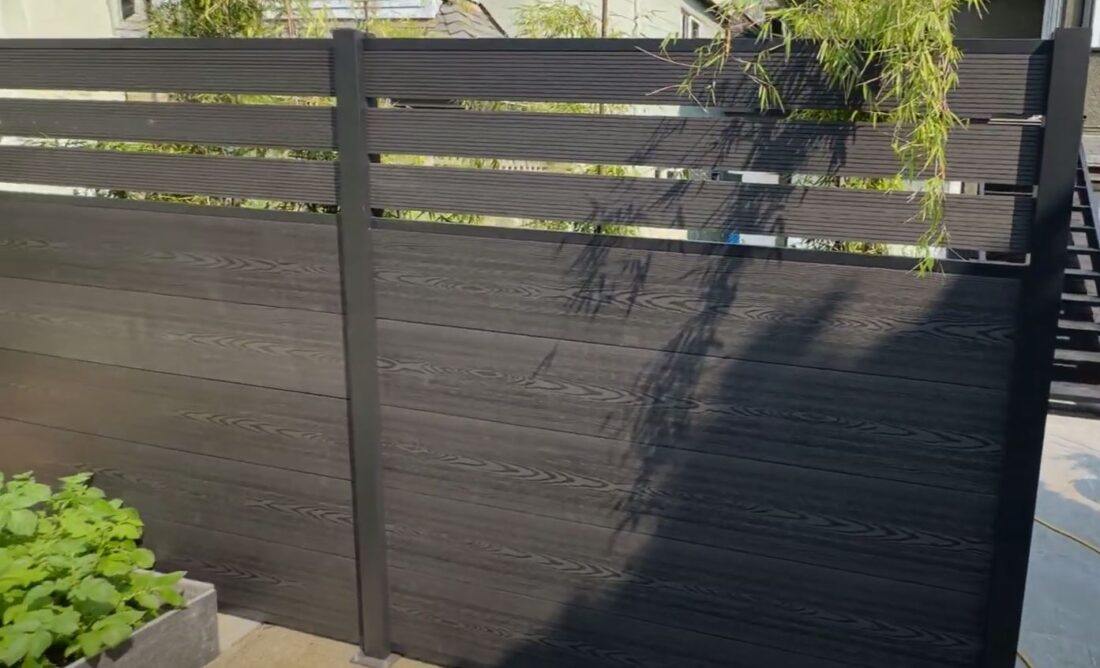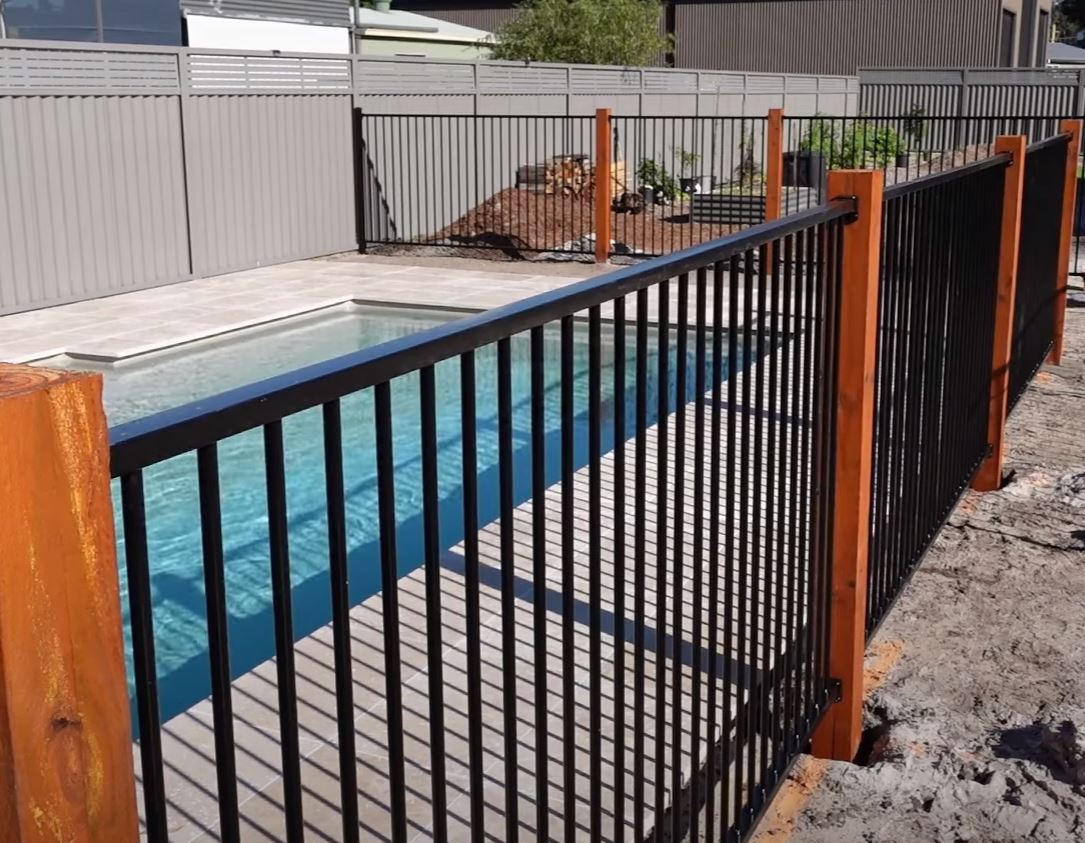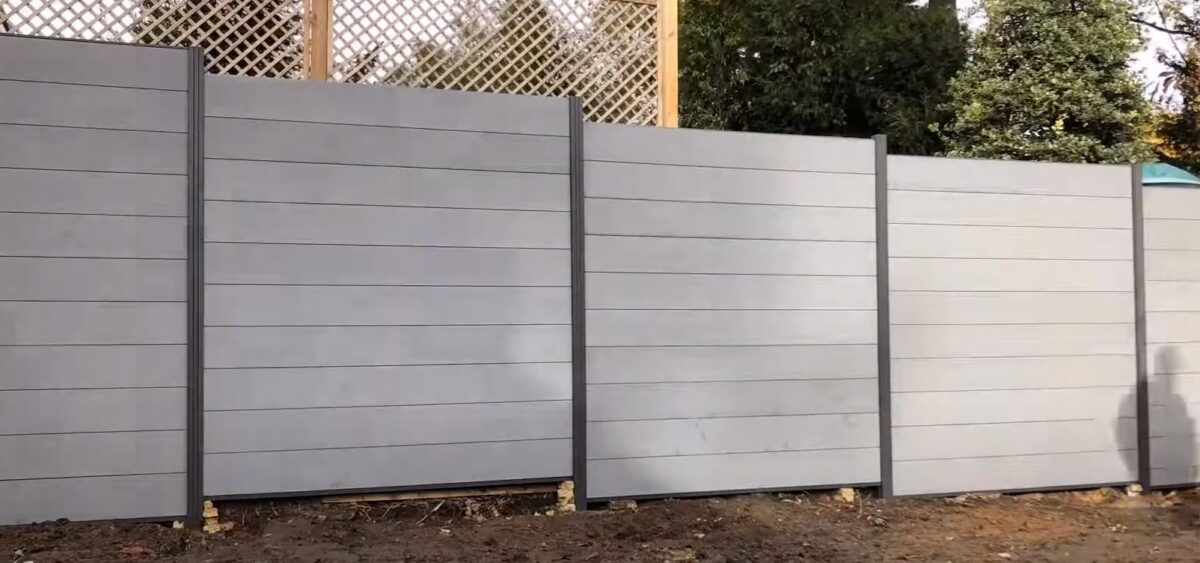Composite Fencing vs. Traditional Wood Fencing
When considering a new fence for your Auckland property, whether it’s in suburbs like Glen Eden or Panmure, it’s crucial to weigh the benefits and drawbacks of composite fencing and traditional wood fencing.
Aesthetic Appeal
- Composite Fencing: This option mimics the look of natural wood but with added uniformity in appearance. Composite fencing comes in a variety of colors and styles, offering aesthetic versatility. It’s particularly known for its neat, consistent look that can complement various architectural styles.
- Wood Fencing: Traditional wood fencing, such as cedar, has a rustic charm and a natural warmth that composite fencing strives to emulate but doesn’t fully replicate. The unique texture and grain patterns in wood add to its classic appeal.
Durability and Maintenance
- Composite Fencing: Notably resistant to weather and pests, composite fencing doesn’t require the regular maintenance that wood does. It’s less likely to experience damage from insects, and its color remains relatively consistent over time, although some fading may occur. It’s a low-maintenance choice that can withstand Auckland’s varying climates well.
- Wood Fencing: While offering timeless beauty, wood fences require more upkeep. They need regular painting or staining to protect against the elements and prevent rotting. Insect damage is a concern, necessitating additional treatments.
Installation and Repairs
- Composite Fencing: Typically made from panels, composite fences can be more challenging to repair as often an entire panel needs replacement if damaged. However, they are generally easier to install.
- Wood Fencing: Wood fences offer more flexibility in repairs; individual boards can be replaced if necessary. Their installation can be more labor-intensive, depending on the design.
Cost Considerations
- Composite Fencing: Generally, composite fencing is more expensive initially than wood. However, its longevity and low maintenance requirements can make it a cost-effective option over time.
- Wood Fencing: Wood fences often have a lower upfront cost but require more maintenance, which can add up in terms of time and money.
Environmental Impact
- Composite Fencing: Many composite fences are made using recycled materials, making them an eco-friendly choice. Their durability means less frequent replacement, reducing environmental impact over time.
- Wood Fencing: Wood is a natural, renewable resource, but it may require chemical treatments for preservation. The sourcing of wood, especially tropical hardwoods, can raise environmental concerns.
Conclusion
Both composite and traditional wood fencing have their merits. For Auckland homeowners looking for a durable, low-maintenance option with a modern appeal, composite fencing is a great choice. For those who value the natural, classic look and feel of wood, and don’t mind the upkeep, traditional wood fencing remains a popular option. When deciding, consider your budget, maintenance capability, and personal aesthetic preference. Consulting with professional Auckland Fence Builders like Quality Fencing Auckland can also help you make an informed decision for your specific needs.
Comprehensive Fencing Options Comparison for Auckland Homeowners
Here’s a comparison table outlining the specifications, differences, pros, and cons of various fencing alternatives. This should provide a comprehensive overview to help you make an informed decision:
| Feature/Aspect | Composite Fencing | Traditional Wood Fencing | Vinyl Fencing | Aluminium Fencing |
| Aesthetic Appeal | Mimics wood, various colors/styles | Natural, rustic charm | Sleek, modern look | Elegant, diverse designs |
| Durability | Weather and pest resistant, does not rot | Requires maintenance to prevent rot | Weather resistant, long-lasting | Resistant to corrosion, long lifespan |
| Maintenance | Low maintenance, occasional cleaning | Requires staining/painting, prone to insects | Low maintenance | Minimal upkeep, occasional rinse |
| Installation & Repairs | Easier installation, panel replacement if damaged | Flexible in repairs, more labor-intensive installation | Easy installation, system based | Professional installation recommended |
| Cost | More expensive upfront, cost-effective over time | Lower initial cost, higher maintenance cost | Moderate cost, low long-term expense | Mid-range cost, low long-term expense |
| Environmental Impact | Often made with recycled materials, eco-friendly | Natural but may require chemical treatments | Less environmentally friendly | Recyclable, sustainable |
| Lifespan | Typically over 30 years, resistant to elements | Varies, depends on wood type and maintenance | Very long-lasting, weather-resistant | Over 30 years, weather resistant |
| Pros | Aesthetically pleasing, durable, low maintenance | Classic beauty, natural look | Low maintenance, modern look | Durable, elegant, low maintenance |
| Cons | Higher initial cost, may fade over time | High maintenance, susceptible to weather damage | Can look less natural | Less strong than steel, higher cost than wood |
This table aims to present a balanced view of each fencing type, considering their unique attributes and suitability for different needs and preferences. For Auckland homeowners, the choice will largely depend on factors like aesthetic preferences, budget, maintenance willingness, and environmental considerations. Consulting with fence installation Auckland experts such as Quality Fencing Auckland can provide further tailored advice for your specific situation.
Composite Fencing Aesthetics vs Traditional Wood Fencing Frequently Asked Questions:
How Does the Aesthetic of Composite Fencing Compare to Traditional Wood?
Composite fencing closely mimics the look of wood with added uniformity in appearance, and is available in a range of colors and styles, offering aesthetic versatility. Traditional wood has a unique rustic charm and natural warmth that is difficult to fully replicate in composite materials.
Can Composite Fencing Achieve a Natural Wood Look?
Yes, many composite fencing options are designed to mimic the appearance of natural wood, including texture and color variations. However, the level of resemblance varies among products and manufacturers.
Is There a Variety in Design Options for Composite Fencing?
Composite fencing offers a wide range of design options, including different colors, styles, and finishes, allowing for customization to suit various architectural preferences.
Does Composite Fencing Fade Over Time Like Wood?
Composite fencing can experience some fading over time, but this is generally less pronounced than the fading and weathering that occurs with natural wood.
How Does the Durability of Composite Fencing’s Aesthetics Compare to Wood?
Composite fencing maintains its aesthetic appeal longer due to its resistance to weathering, pests, and rot, unlike wood which requires regular maintenance to preserve its look.
Can Composite Fencing Be Painted or Stained Like Wood?
While composite fencing typically comes pre-colored and does not require painting, it can be more challenging to paint or stain than wood due to its material composition.
Does Composite Fencing Offer the Same Textural Features as Wood?
Composite fencing can mimic the texture of wood, but the tactile experience may differ slightly due to the composite material’s nature.
Are There Eco-Friendly Aesthetic Options in Composite Fencing?
Many composite fencing products use recycled materials, making them an environmentally friendly choice. They come in various eco-conscious designs and styles.
Is Composite Fencing Suitable for Traditional Home Designs?
Yes, composite fencing can be suitable for traditional home designs as it offers styles that mimic the classic appearance of wood fencing.
How Consistent is the Coloring in Composite Fencing Compared to Wood?
Composite fencing generally offers more consistency in coloring compared to wood, which can have significant natural color and grain pattern variations.
Does Composite Fencing Require the Same Level of Upkeep to Maintain Its Aesthetic as Wood?
No, composite fencing requires much less maintenance to maintain its aesthetic compared to wood, which needs regular staining or painting.
Can Composite Fencing Provide a Rustic Aesthetic Similar to Traditional Wood?
While composite fencing can mimic the look of wood, achieving the same rustic aesthetic as certain types of traditional wood may be challenging.
How Does Weather Affect the Aesthetic of Composite Fencing Compared to Wood?
Composite fencing is more resistant to weather-related aesthetic deterioration, such as warping, rotting, or fading, compared to wood, which is more susceptible to weather damage.
Can Composite Fencing Be Customized to Specific Architectural Styles?
Yes, composite fencing is versatile and can be tailored to fit various architectural styles, thanks to its wide range of design options in terms of colors and patterns.
How Well Does Composite Fencing Blend with Natural Landscaping Compared to Wood?
Composite fencing can blend well with natural landscaping, especially styles that mimic wood aesthetics. However, traditional wood fencing may have a slight edge in blending seamlessly due to its natural material.
Is Composite Fencing Available in Different Textures?
Composite fencing comes in various textures, some of which closely resemble the texture of natural wood. Manufacturers often offer different options to suit different preferences.
How Reflective is Composite Fencing Compared to Wood?
Composite fencing generally has less natural luster than wood and may appear less reflective. This can be advantageous for homeowners who prefer a more subdued fence appearance.
Does Composite Fencing Offer the Same Warmth and Homeliness as Wood?
While composite fencing can mimic the look of wood, it may not fully replicate the inherent warmth and homeliness of natural wood fencing.
How Does the Feel of Composite Fencing Compare to Wood When Touched?
The tactile experience of composite fencing can differ from wood due to its material composition. Composite tends to feel smoother and less grainy than natural wood.
Are There Any Unique Composite Fencing Designs That Aren’t Possible with Wood?
Composite fencing can offer unique designs and patterns that might be challenging to replicate with natural wood, especially those that require uniformity in shape and color.
How Does Sun Exposure Affect the Color of Composite Fencing Compared to Wood?
Composite fencing is generally more resistant to color fading from sun exposure compared to wood, which can experience significant color changes and may require more frequent staining or painting.
Can Composite Fencing Achieve a Vintage or Antique Look Like Wood?
While composite fencing can be styled to look older, achieving an authentic vintage or antique look may be more naturally accomplished with traditional wood fencing.
Is the Variety of Colors in Composite Fencing Comparable to Wood?
Composite fencing offers a wide range of color options, some of which mimic natural wood hues. However, the color variety in wood is inherently broader due to natural variations in wood species.



